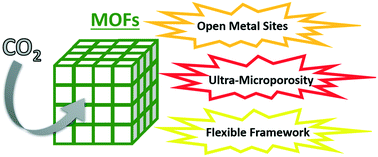CO2 adsorption mechanisms on MOFs: a case study of open metal sites, ultra-microporosity and flexible framework
Abstract
The hazardous emission of CO2 in the atmosphere is a concerning topic when addressing climate change issues. The mitigation of this greenhouse gas has attracted great attention in the realm of a sustainable economy, especially regarding the design of novel CO2 capture technologies. Metal–organic frameworks (MOFs), a class of hybrid porous materials, stand out as efficient carbon capture and sequestration (CCS) materials, which have a CO2 capacity of similar range or superior to the standard employed adsorbents, such as zeolite 13X and activated carbon. Taking into account the promising future of MOFs as CO2 adsorbents, it is therefore of utter importance to understand the CO2 adsorption mechanisms in these porous materials, which can contribute to further improvement of their performance. In this review, we explore the CO2 adsorption mechanisms of diverse MOFs, namely MOF-74-Mg, HKUST-1, SIFSIX-3-M (M = Fe, Co, Ni, Cu, Zn), and ZIF-8. These materials show interesting features as open metal sites, ultra-microporosity, and flexible framework, which are present in the majority of MOFs used for this application. Studies regarding their preferential adsorption sites, water stability, CO2–MOF complex configuration, CO2 adsorption dynamics, bonding angle, decomposition mechanism, and swing effects were addressed in this contribution.



 Please wait while we load your content...
Please wait while we load your content...